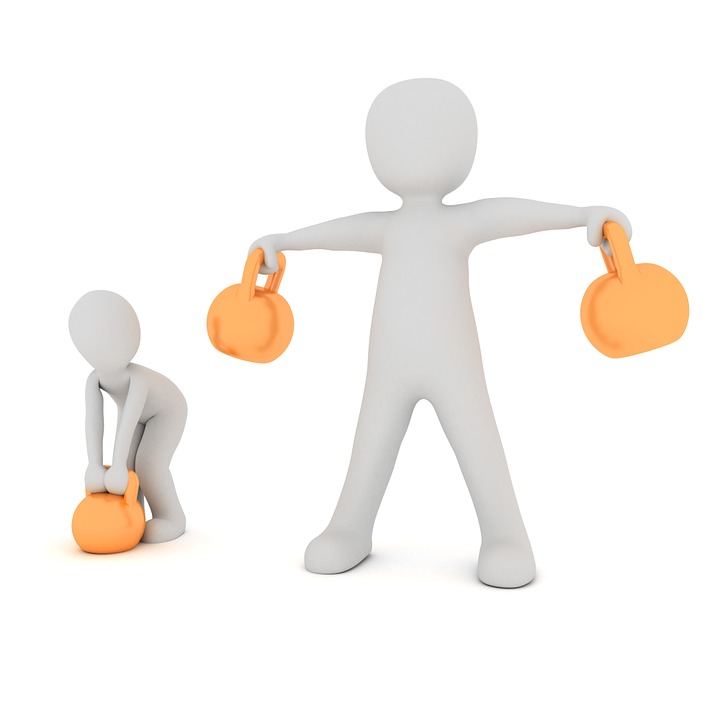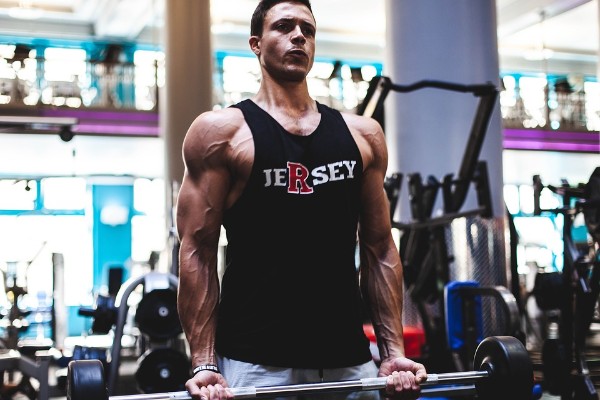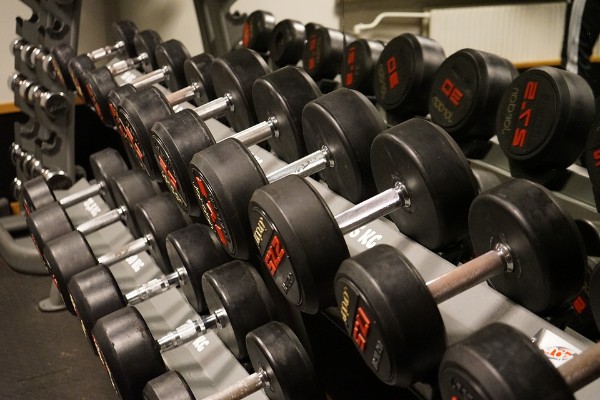The dumbbell squat is a well-known fundamental exercise to develop strength and power in the quads, hamstrings, and glutes. It involves engaging muscles in the hips and legs.
Dumbbell squats are the ideal exercise to practice good form because they tend to use lighter weights as resistance for a higher number of reps. They might not look as impressive as squatting a heavy barbell, but they are just as effective.
Why Should You Be Doing Dumbbell Squats?
You’ll learn the squat in your very first exercise class, which is a well-known exercise. It’s a lower body exercise that helps some of the key muscles we rely on for movement and explosiveness grow stronger. Whatever level of athlete you are, squats are beneficial for a variety of sports. Run more quickly, jump higher, and lift more weight.
Squats are an effective exercise for improving balance and posture, strengthening the core, and reducing the risk of injury.
How To Do Dumbbells Squats?
There are numerous dumbbell squat exercises, but we will only discuss the conventional ones here. Try this movement and once you get comfortable with this workout at home or the gym, you can move to more challenging dumbbell squats:
- Place your feet slightly wider than shoulder-width apart when standing.
- Keep your hands by your sides while holding the dumbbells in each.
- Maintain a straight back and a flexed body as you inhale.
- Bend your knees and contract your abdominal muscles to bring your body to the ground. Once your thighs are parallel to the ground, keep bending your knees. Be certain that you have a firm grip on the dumbbells.
- To get back to the starting position, straighten your legs.
- This is one rep; do it again.
Notes:
Start the squats without any weights if your body is not accustomed to carrying weights, as is the case for beginners. When you are an expert, switch to dumbbell squat exercises. Remember to warm up before your workout as well.
How Do I Know When To Add More Weight?
You should increase the weight you squat as you get stronger. But how can you tell when it’s appropriate? And how much weight should you add to your dumbbell squats to make sure they’re secure and efficient?
There are a few questions to consider if you want to move on to heavier dumbbells:
- Can you perform 15 reps with good form and a reasonable amount of effort?
- Do you want to challenge yourself because you feel like you’ve reached a plateau? Following each set, how do you feel?
- Have you tried upping the weight while doing fewer reps? Instead of thinking about 10–12, think about 6–8.
A good rule of thumb is to increase each weight by 10%, so if you start your dumbbell squat with 10 kg (22 lbs) per dumbbell, try increasing each one to 12 kg (26 lbs), and so on. This will prevent your muscles from becoming overworked and gradually increase the resistance, assisting in preventing injury.

Benefits Of Dumbbell Squats
A compound exercise that uses two dumbbells is the dumbbell squat.
They are an essential tool for achieving your training objectives, whether you choose a set of rubber hex dumbbells or take the neoprene dumbbells out of the back of your spin bike.
The benefits include:
Less Equipment Required
The squat rack is THE most used piece of weightlifting gear at my neighborhood gym.
(Whether people are actually using it for squats is another matter…)
The truth is that barbell squats—and consequently, the rack needed to hold them—are the most widely used form of exercise in the gym.
When you use dumbbells for squats, you can skip the line, grab a set of the best dumbbells for the workout, and find a quiet spot in the gym.
Dumbbells are a great alternative to a squat rack for people who exercise at home and don’t have the luxury or room to own one.
(Adjustable dumbbells take the space-saving awesomeness to the next level. Here is my review of the top adjustable dumbbells.)
Since you can use dumbbells almost anywhere and they don’t require the same equipment as rack-based squats (weight plates, a barbell with a collar, a squat rack, etc.), they make excellent squat resistance.
Work All The Muscles As A Barbell Squat (And Even A Little More)
There is some evidence that at more moderate intensities you are getting the same muscle activation as you would with a barbell, even though many of us will struggle to reach the same peak power output with dumbbells as we could with a barbell.
In one study, ten well-trained young men performed squats and lunges while using a weighted vest, a loaded barbell, dumbbells, a kettlebell, or just their body weight as a control.
Barbells and weighted vests were beaten by dumbbells (and destroyed by kettlebells) in terms of activating the quadriceps muscles.
Despite the fact that this is only one study, it should give those looking to develop their general strength and hypertrophy at the gym great comfort.
Dumbbell squats are one of your best options for creating resistance if all you want to do is simply gain some muscle.
Easier On The Body
Dumbbell exercises are generally safer than barbell exercises, which is one of the reasons I love using them for bench presses and squats.
This is due to a few factors.
First, unlike a loaded barbell, dumbbells won’t compress the spine as much. Your back is not working when you descend and pop out of a squat because the weight is at your side.
Second, dropping a barbell loaded with weight plates and damaging your garage floor are both risks associated with failing a rep with a barbell, which can result in you collapsing under the barbell.
For the spine and shoulders, dumbbells don’t cause the same level of sheer discomfort.
They have shorter to drop, have less combined weight, and don’t “weigh down” the vertebra in your spine.
Better For Lifters With Poor Shoulder Mobility
To keep the barbell firmly in place on your back while performing barbell squats, externally rotate your arms.
For lifters who are unable to externally rotate their shoulders enough to properly hold a barbell during back squats, dumbbell squats are a great alternative.
Although there are a few ways to fix this, like widening your grip, raising the barbell, and flaring your elbows, the truth is that not everyone can get their palms underneath the bar to hold it in place.
While you work on improving your ability to externally rotate the shoulders, dumbbell back squats are a good substitute for a barbell back squats.
Easier To Ditch
Dumbbells and machines are my go-to tool when I am doing a “finisher” set.
(Choosing a moderate weight at this point, you should push the movement all the way to failure. Best done at the end of your workout for maximum “pump” and effort.)
The explanation is straightforward: I want to be able to fail and drop the weights safely when my muscles are burning and I can hardly lift them any higher.
When your muscles exhaust themselves and you want to stop lifting weights without injuring yourself, dumbbells are safer to abandon.
Gluteus Maximus
The gluteus maximus, which is the largest and heaviest muscle in the body, is used little during regular walking but is essential for powerful lower limb movements like stepping, climbing, and running.
This large muscle rotates the hip joints, and because of its size, it exerts a lot of force. It is important to build up this muscle over time because it supports numerous functional fitness movements, particularly in CrossFit. The muscle has a role in stability as well as erect posture and pelvic changes. As one of the muscles that extend the hip joint, it helps to keep the spine straight.
Squats, in all of their variations, are among the best exercises for this muscle.
Quadriceps
The four larger muscles that make up your quads, also known as “The Heads,” are situated in the front of your thigh.’ These muscles are:
- Rectus femoris muscle (occupies the middle of the thigh, covering most of the other three quadriceps muscles)
- Vastus lateralis muscle (on the outer side of the thigh)
- Vastus medialis muscle (on the inner part thigh)
- Vastus intermedius muscle (on the top or front of the thigh)
Another strong muscle group responsible for force and forward motion is the quads. They are strong knee extensors that help you maintain an upright posture and a stable kneecap. These muscles are essential for squatting, running, and walking.
Our quadriceps are vulnerable to injury because we use them so frequently. The best way to prevent quad injuries is through strength training and exercises like dumbbell squats.
Stronger And Muscular Legs:
Dumbbell squats are essential for the growth of your leg muscles because they work all of the main muscles in your legs. It targets the glutes—the gluteus maximus and medius—which are in charge of producing the majority of the power in your lower body. Your body’s stability and strength are subsequently improved.
Furthermore, all four quads (rectus femoris, vastus medialis, vastus lateralis, and vastus intermedius) can be bulked up. These give your knees stability and protection. Regular dumbbell squat workouts also help build strong hamstrings and calves.
Improved Core Strength:
The dumbbell squat is a common lower-body exercise that also strengthens your core. The core muscles contract as you raise and lower your body. Here, your entire torso is meant, not just your abs. Your back and chest muscles assist with stability while you are holding the weights. Your entire core will become stronger as a result of dumbbell squats.
More Power And Endurance
Squats are very effective at boosting your body’s overall power and endurance. They have also been known to help you jump higher. This aids you in activities that call for running, jumping, or lifting heavy objects. Such tasks become simple when you have strong legs, and you have more endurance and strength.

Disadvantages Of Dumbbell Squats
After praising the dumbbell squat for the past few paragraphs, let’s now discuss some of its drawbacks.
Dumbbell Squats Have A Ceiling In Terms Of Resistance
Your ability to lift more weight will increase dramatically as your strength and squat technique develop.
The amount of weight you can lift with dumbbells is constrained by how much you can hold, making them more difficult to scale.
Additionally, heavier dumbbells are bulkier and more difficult to hold beside you.
This is typically a pretty good problem to have because, after all, you are getting stronger!—but many lifters find it difficult to squat properly with 120lb dumbbells at their side.
Rounded Back Syndrome.
Dumbbells are by no means the only solution to this problem, but I’ve observed that as lifters tire from doing dumbbell squats, they start to become a little careless about where the weight is placed.
The lifter leans forward to counterbalance the weight as the dumbbells start to drift forward, which causes the back to round.
When performing squats with dumbbells, keep the weights vertical and prevent them from swinging forward as you come down.
Consider using a couple of small weight plates (5 lbs) under your heels as a squat wedge (or buy a pair of squat shoes) to extend the proper range of motion if you are unable to perform the exercise properly without bending forward.
The Bottom Line
The tools you use when performing any type of resistance training have a significant impact on how well the movement is executed, including how safely it is performed and which muscles are recruited.
There are many benefits to including dumbbell squats in your workout, regardless of your fitness objectives, from muscle growth to high-performance sports.
Grab some dumbbells and start your squats the next time you go working out.
FAQ
Are Squats With Dumbbells Effective?
Your lower body and core will get stronger from dumbbell squats.
Your posterior chain muscles, like the hamstrings and gluteus maximus, are more activated as a result of the added weight from a pair of dumbbells. The muscles that support your knees and ankles are also tensioned by dumbbell squats.
Is It Better To Squat With Dumbbells Or Barbells?
Barbell squats are undeniably better than dumbbell squats in building lower body strength and power. Overall leg strength, including that of the knees and lower back, is greatly enhanced by barbell squats’ heavier weights. Additionally, it enables a weight increase that is gradual for more progressive overloading.
How Many Dumbbell Squats Should I Do?
Dumbbell Squat Workout
(OR Compound Set 2 or more exercises back-to-back for the recommended number of sets and reps. Beginner: 3 sets of 12–15 repetitions; intermediate: 4–6 sets of 15-20 repetitions; advanced: 6–8 sets of 40–60 repetitions.
